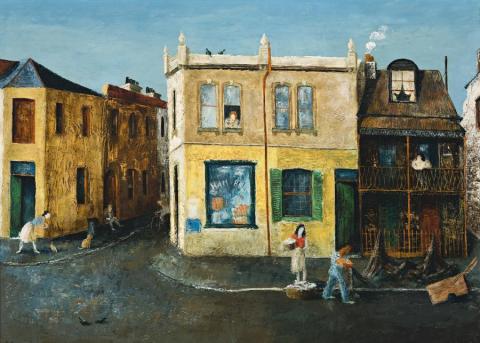STREET SCENE PADDINGTON, 1952
Sali Herman
oil on canvas
64.0 x 89.5 cm
signed and dated lower left: S. Herman. 52
Acquired from the artist
Private collection, Melbourne
During the 1940s, Sali Herman emerged as the master landscape artist of Sydney's inner city Victorian terraces. In 1944, he won the Wynne Prize with his painting McElhone Stairs. This was followed by such outstanding works as The Law Courts, 1946, (Felton Bequest, National Gallery of Victoria), House on the Hill, 1947, a crowning triumph of angularity, and Near the Docks, 1949, (Art Gallery of New South Wales). Each he humanised with the addition of figures and related urban activities. Street Scene Paddington, 1952, is vintage Herman, being full of anecdotal detail about the buildings and the people who lived in them. The buildings are not just architecture, but characters in their own right, each with its story to tell. Narrated through their shapes and sizes, a bright colour note here, or a darker, rusty glory there, painted signs and graffiti added to their presence. Our corner store invitingly offered 'HAM' and 'BEEF' in big letters across its window, while Suburbia, 1947 with its truncated 'VOTE 10 P.M.' commented on a referendum about pubs and drinking laws. August of age, yet crumbling with wear and tear, their textures are full of visual appeal. For Herman enjoyed the tactile pleasure of paint, brushing, scraping and scrumbling to achieve the plastered surfaces, of terracotta, stone, and rusty iron.
The occupants are as much a part of the buildings as the buildings are part of their lives - imbued with a lively curiosity. A redhead looks out from an upper window, another woman leans over a cast iron balcony, while the cat is intrigued by the approaching cyclist. (Cats were a favourite Herman touch, as seen in profusion in others works as Feeding the Cats, 1952, formerly in the collection of Mr & Mrs Kenneth Myer, and The Red House, awarded the 1965 Wynne Prize.) The viewer is soon swept up in this curiosity, particularly through the street dialogue between the woman with her baskets of washing, and her neighbour, hanging his fishing net out across the cast iron fence. And so the drama of the street life unfolds. Over all the sky is clear and blue, its bright appeal heightened by two homely puffs of smoke. Although he painted portraits, Aboriginal subjects and the Outback, Herman's favourite paintings have always been his inner cityscapes. Their popularity was such that, in the late 1950s they played an influential role in the emancipation of the Victorian terrace house and its growing fashionability. Today, this quintessentially Herman painting reminds us of those days when their life pulse was more picaresque.
DAVID THOMAS
